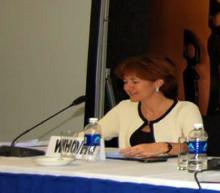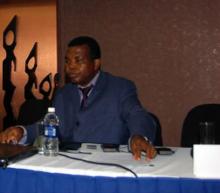Recommendations from the regional meeting for mapping of unmet country needs to accelerate the implementation of the International Health Regulations (2005) in the African Region
Lusaka 07 December 2012 -- The World Health Organization Regional Office for Africa (WHO/AFRO) and WHO Global Capacities, Alert and Response stakeholders regional meeting for mapping of unmet country needs to accelerate the implementation of the International Health Regulations (2005) in the African Region came to a conclusion on 6th December 2012. The WHO Country Representative, Dr. Olusegun Babaniyi officially closed the meeting.
In his closing remarks, he stated that WHO was committed to working with countries and other partners in supporting countries to develop IHR (2005) core capacities in line with the priorities which were identified during the meeting. He said that WHO would continue to provide guidelines and standards, support countries to conduct regular assessments of IHR core capacities, support strengthening of national laboratories and introduction of laboratory services at Points of Entry, revision of legislation and policies to hasten IHR implementation including the development of human resources. Dr. Babaniyi urged countries to contribute to the Public Health Emergency Fund (PHEF) which was created by WHO for use in addressing emergencies and disasters.
The section below provides a summary of the meeting objectives, achievements made by the State Parties, major gaps and challenges and the recommendations for IHR (2005) implementation in the countries* represented at the meeting.
Meeting Objectives
- Provide a forum for all stakeholders – Member States, WHO (headquarters, regional, and country offices), technical partners, and donors – to review the current regional situation in implementation of the IHR (2005), identify main achievements, and identify gaps and challenges
- Provide the opportunity for all stakeholders to identify recommendations and solutions to address the challenges and bridge the gaps identified
- Set the stage for further discussions on future strategies for collaboration, and partnership and the mobilization of technical and financial resources required to meet core capacities
- Endeavour to match identified needs, gaps, and priorities to available support and identify next steps in IHR core capacity development
Representative Member State Achievements
Member States were provided the opportunity to highlight their achievements in implementation of the IHR (2005) through oral presentations, poster presentations, discussion among meeting participants, and capacity-specific working group discussions. The following list highlights representative Member State achievements; additionally, each of the Member States listed below has offered to assist other countries in capacity building of the identified area of expertise.
- Ghana discussed their successes in community-based surveillance and offered to share their experiences, tools, guidelines, and training manuals.
- Ethiopia has successfully revised national legislation to include the components necessary for implementation of the IHR (2005) and is willing to share experiences in development of legislation and provide technical support in preparation of IHR-related legislation.
- Nigeria shared their recent experiences in responding to chemical emergencies and the lessons they have learned from these recent events. Nigeria is pleased to share their experiences in handling chemical emergencies with other countries in the region.
- Kenya described their successes in the areas of surveillance and epidemiology training, activities at the interface of human and animal health, cross-border surveillance and joint response, establishment of an electronic tool for Integrated Disease Surveillance and Response (IDSR), and revision of their IDSR strategy. Kenya offered to share their experience and expertise in each of these areas and to provide technical support as available.
- Zimbabwe has demonstrated success in the area of surveillance, including establishment of electronic reporting in their IDSR program. Zimbabwe extended an invitation to other countries for collaboration in the area of surveillance.
- Tanzania has been successful in development of human resources for health programs and is able to support other countries in soliciting support for establishment of training programs. Additionally, they can share experiences in development of an all-hazards preparedness plan.
- Namibia has also successfully revised their national legislation and revised the Public Health Act to include IHR (2005). Namibia offered technical assistance to other Member States in the incorporation of IHR (2005) into their national legislation.
- Uganda has significant experience in dealing with outbreaks of viral haemorrhagic fevers and has developed capacity in emergency response, risk communication, and infection prevention and control. Uganda can be called upon to assist with outbreak response and to provide technical assistance in risk communication and response.
- The Seychelles successfully implemented web-based surveillance, which has linked the many islands of this nation. The Seychelles can share their experiences in web-based surveillance with other countries. Additionally, they can provide technical assistance in incorporating non-communicable diseases into revised IDSR guidelines.
- Sierra Leone enhanced their capacity for risk communication during the recent cholera outbreak and is willing to share their experiences in risk communication with the region.
- Liberia has experience in response to outbreaks of yellow fever and other diseases and can be called upon for technical assistance during disease outbreaks.
- Zambia has advanced capacity in management of radiological events; legislation and policies are in place and detection capacity is established. Zambia is willing to support Member States in capacity building for radiological and nuclear hazards.
Representative Gaps and Challenges in IHR (2005) Implementation
Through presentations by Member States, discussion among meeting participants, and capacity-specific working group discussions, numerous priority gaps and challenges in IHR (2005) implementation were identified. The following gaps and challenges are representative of the complete list of gaps and challenges identified during the meeting.
- Developing necessary legislation to fully implement the IHR (2005)
- Establishing multi-sectoral cooperation and coordination on all core capacities
- Enhancing human resources across all core capacities and IHR (2005) hazards
- Strengthening of core capacities at points of entry (POE) for chemical, biological, nuclear and radiological hazards
- Developing integrated surveillance systems and networks for communicable diseases and other hazards
- Establishing national risk communication policies, methodologies, guidelines, and tools
- Designating POE and implementing of ship sanitation inspection procedures
- Enhancing laboratory capacities for the diagnosis of chemical, biological and radionuclear events
- Fully implementing the Integrated Disease Surveillance and Response (IDSR) strategy
Recommendations
The meeting proceedings included extensive discussions, exchange of information and sharing of experiences and lessons learned. These discussions led to the following recommendations for Member States, WHO, donors and technical partners.
Member States
- Establish or reinforce the core capacities at designated POE, including equipment of designated POE and recruitment of personnel to develop, strengthen and maintain core capacities on a routine and emergency basis including contingency plans
- Assess and revise, where necessary, national legislation to comply with IHR requirements
- Strengthen coordination of and collaboration in IHR-related issues among Member States and between relevant sectors and partners in order to develop, establish and maintain core public health capacities and enhance on-going cooperation at interface of human and animal health
- Build sustainable risk communication capacity through developing and operationalizing risk communication strategic frameworks
- Fully implement the revised IDSR strategy, strengthening the core capacities of surveillance (including event-based and community surveillance), preparedness, laboratory and response
- Strengthen laboratory capacity building and networking, including enhancement of quality assurance and quality control programs, training in biological risk management, enhancing diagnostic capability and technical training
- Focus on building sustainable human resource capacity across all core capacities, including development of national human resource strategies and establishment of training programs
- Provide the IHR National Focal Point (NFP) with adequate means of communication and establish mechanisms of retaining members of the IHR NFP to ensure timely verification and notification of public health events
- Continue to strengthen capacity to detect and manage food safety events, including through membership in the International Food Safety Authorities Network (INFOSAN) and through ensuring a strong linkage between the IHR NFP and the INFOSAN focal point
- Promote cross-border collaboration in disease surveillance and risks of common concern
- Provide technical, logistical and financial support to other Member States, to the extent possible and upon their request, to build and maintain their public health core capacities
- Undertake regular mapping, assessment, monitoring of IHR implementation and evaluation of existing capacities and consider hosting regular national IHR stakeholders’ meetings
- Report annually to WHO on the progress in strengthening and maintaining national core public health capacities required under IHR and in line with the national implementation plan
For WHO
- Develop relevant guidance for enhancing the core capacities to handle all hazards, including zoonoses, food safety, chemical safety, and nuclear and radiological events, as well as vector surveillance and control and POE
- Organize regular forums to share best practices, lessons learned and materials with other countries in the region and between regions, including similar stakeholders’ meetings
- Provide technical and logistical support and facilitate mobilization of resources to States Parties, upon request, for building and sustaining the core capacities for surveillance and response
- Foster partnership and engagement with international organizations and partners
- Facilitate experience sharing and information exchange between States Parties, including by posting a relevant summary of the information collected through the IHR monitoring framework
- Monitor the progress made in the implementation of, and the sustainability in achieving, the national core capacities required under the International Health Regulations (2005) in all States Parties
- Assist with development and conduct of exercises and drills
- Provide additional support and guidance for building capacity at POE
For Donors and Technical Partners
- Provide capacity building across all core capacities through regional and country offices
- Support regional activities, in addition to traditional bi-lateral engagements
- Work closely with WHO to identify opportunities for partnership and collaboration in the region
- Provide financial and technical support
- Support and enhance regional and international networks, as well as WHO collaborating centers, to support development of core capacities
- Ensure all bi-lateral and regional engagements are coordinated and aligned with existing WHO and Member State strategies and activities
- Advocate to high-level government authorities to ensure commitment to IHR implementation
Next Steps
At the conclusion of the meeting, Member States and donors provided statements and offered their support to countries in the region. Donors expressed their commitment to support WHO and Member States and Member States reaffirmed their commitment to support each other. The following next steps were identified.
- Investigate the possibility of a legislative workshop for countries in the African region
- Set up a community of practice for NFPs
- Identify specific opportunities for country-to-country support
- Continue to revise the IDSR Technical Guidelines, and ensure staff are trained in the revised guidelines which take into account the IHR (2005)
- Member State participation in existing regional and international networks, including INFOSON, the Event Information System (EIS), the POE Database and the Ports, Airports, and Ground Crossing Network (PAGNet)
- WHO will host a workshop on capacity building at POE (specifically on ship sanitation inspections and ship certificate issuance) in Durban, South Africa, in December 2012
- WHO will complete and share the IHR Implementation Costing Tool as soon as possible
- WHO will share information on submitting official requests for IHR (2005) extensions
- Ensure all donors and technical partners receive meeting information and are provided the opportunity to discuss potential support
*Botswana, Eritrea, Ethiopia, Gambia, Ghana, Kenya, Lesotho, Liberia, Malawi, Mauritius, Mozambique, Namibia, Nigeria, Rwanda, South Africa, Seychelles, Sierra Leone, Tanzania, Uganda, Zambia and Zimbabwe.
For more information contact:
Nora Mweemba, Health Information and Promotion Officer.
WHO Country Office, UN ANNEX BUILDING, Plot 4609, Corner of Andrew Mwenya and Beit Roads, Rhodes Park, P.O. Box 32346, Lusaka, Zambia., E-mail: mweemban [at] zm.afro.who.int (mweemban[at]zm[dot]afro[dot]who[dot]int), GPN: 37609, Tel No: 00-260-211-255 398 / 255 336 / 255 322, Mobile : 260 - 977873976, Fax: 00-260-211-252863
Dr. Stephanie Bumpus, Public Health Analyst, Division of Global Disease Detection and Emergency Response, Global Health Security Branch. U.S. Centres for Disease Control and Prevention/ Centre for Global Health. E-mail wve [at] cdc.gov (wve[at]cdc[dot]gov), Tel: +1-404-718-4869






